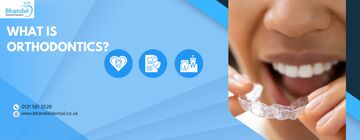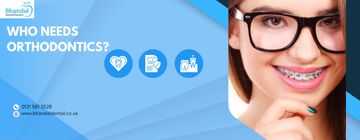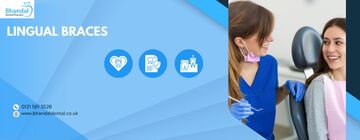
December 7, 2023
A full Guide to Orthodontics
Learn everything there is to know about orthodontic treatment with our comprehensive guide.
Orthodontic treatment has come a long way in recent years. While traditional fixed braces are still widely used, there are plenty of other treatment options available. The age range of the typical patient has also become much wider. Many people are turning to orthodontics later in life to help achieve their perfect smile.
If you’re curious about orthodontics but want to know more about treatment, we’re here to help. We’ve compiled this extensive guide to orthodontics so you can move forward and book a consultation in confidence. By the end of this article, you should be familiar with the most popular types of treatments and who would make a good candidate for orthodontics.

What is orthodontics?
Orthodontics is a specialised field of dentistry that focuses on the diagnosis, prevention, and treatment of misaligned teeth and jaws. The goal of orthodontic treatment is to achieve proper bite alignment and improve the overall function and appearance of the teeth.
Orthodontic treatment often involves the use of dental appliances such as braces, aligners, and other devices to apply gentle pressure on the teeth, gradually moving them into the desired positions.
Orthodontic treatment not only improves the aesthetics of a person's smile but also contributes to better oral health by reducing the risk of dental problems associated with misaligned teeth, such as difficulty in cleaning, increased risk of decay, and jaw pain.

Who can do orthodontic treatment?
Only an orthodontist should carry out orthodontic treatment under direct supervision. This is why we don’t recommend mail-order orthodontic treatment, as you won’t have direct access to an orthodontist to help monitor your progression.
While you might be able to save money on your treatment, the money saved is simply because you don’t have direct supervision from an orthodontist. A lot can go wrong during treatment and it’s important to have regular checkups to ensure everything goes to plan.

Who needs orthodontics?
There are many reasons to turn to orthodontics, including aesthetic and functional improvements. Many people want to have treatment so that their smile will be picture-perfect. Others are concerned about the health of their teeth due to a poorly aligned bite. It could also be a combination of factors.
With NHS treatment, you need to meet specific parameters, including being 18 or under. With private treatment, there are no age restrictions and you don’t have to have a specific level or orthodontic need to be eligible. You can get started with the treatment that works for you when it is most convenient.

Types of orthodontic treatment
There are many different types of orthodontic treatment available. These will suit a wide range of individuals, from those who are looking for fast and effective results, to those looking for a treatment that is as discreet as possible. Here are some of the most common orthodontic options available:
Traditional fixed braces
Fixed metal braces are highly effective and well-recognised. With this treatment plan, a bracket is fixed to each tooth and a wire is passed between them. The wire can be adjusted to apply strategic pressure to the teeth and encourage them into the correct alignment.
If you don’t like the look of the traditional fixed metal braces, there are more discreet options available. You could have tooth-coloured ceramic brackets and clear wires, which will be much more discreet than the traditional metal option.
Traditional fixed braces can take around 12 to 24 months before you will see the results you want. Once you are done with treatment, the braces are removed and you will need to wear a retainer at night time to keep your teeth in the correct position. You may have the option to have a fixed retainer bonded to the back of your teeth.

Lingual braces
If you would like to explore traditional fixed braces but don't want anyone to know you are having treatment, lingual braces can help. Instead of fixing the brackets to the front of the teeth, they are fixed to the back. This makes them nearly invisible and will also help with some of the discomfort you might experience in your cheeks and lips.
Lingual braces take around 12-24 months to achieve the optimum results and you will need to visit the dentist for regular checkups and adjustments during this time.
Invisible braces
If fixed braces don’t appeal, one alternative would be clear plastic aligners. These are removable and nearly invisible, which makes them ideal for anyone who feels self-conscious about undergoing treatment.
The most popular invisible aligner brand is Invisalign. With this treatment plan, you will receive a case of aligners that you wear in order. Each aligner is typically worn for 10-14 days before moving to the next set in the case. With every aligner change, you’ll get a little bit closer to perfect alignment as they apply gentle pressure to your teeth.
Treatment can take from 6 months to 2 years, depending on the severity of your case and if you choose to straighten all of your teeth or just the front teeth. The good news is that most people don’t mind the treatment time, as they can remove their aligners to eat, drink and brush their teeth. This makes the treatment process far easier to manage.

Choosing the right treatment path
If you would like to explore orthodontic treatment options, the first step is to book a consultation with your dentist. This is an opportunity to learn more about the options available and to find out if you are a suitable candidate. If you are a suitable candidate, you can then explore payment options, including financing and payment plans.
When choosing the right treatment path, ask yourself the following questions:
Am I likely to forget to wear my aligners?
If you are forgetful or prone to losing things, a removable system like Invisalign might not be right for you. You need to wear your aligners for 20-22 hours per day, so if you think you might forget to do this, a fixed orthodontic system might be better.
Can I attend regular appointments for adjustments?
If you are very busy and would struggle to fit in regular dentist appointments, a system like Invisalign might be better. With Invisalign, you change your aligners regularly at home and only need to attend check up appointments at intervals throughout your treatment plan.
Am I in a hurry to see the results?
If you are in a rush and have a deadline, you might want to consider Invisalign treatment that will only focus on the top front teeth. This will speed up the treatment time and focus on aesthetic results, rather than proper alignment of all teeth and your bite.
Could other treatments achieve my goals?
There are other treatments available such as veneers and composite bonding that could provide similar results. It’s worth exploring all of the options available to you before going forward with any treatment plan.
Ready to get started?
If you’re ready to start exploring your treatment options with the Bhandal Group, find your nearest practice today. We will arrange a consultation so you can learn more about the treatments available and ask any questions you might have about how it works.
Join the practice
We offer excellent care and advice regarding our wide range of treatments to all of our patients.
Contact our main practice
0121 561 3526Find your nearest practice
Related articles
You may also be interested in
